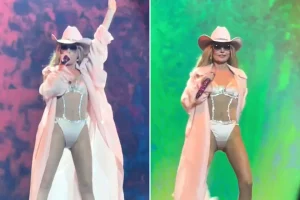Bold Return to the Spotlight: Shania’s Statement Outfit
In her latest Las Vegas residency — Come On Over – All The Hits! — Shania Twain stepped back into the spotlight with a bold and eye‑catching outfit. At age 59, she appeared on stage in a sparkling, metallic bodysuit, paired with a vivid pink jacket and her trademark cowboy hat. The look was striking, theatrical, and clearly intended to make an impression. Media coverage noted that the striking two‑piece — along with the overall stylized presentation of the show — immediately triggered strong responses online.
For Twain, this isn’t just about clothes — it’s part of the performance. In fact, she has spoken about how she personally designs many of her stage outfits, underscoring that wardrobe is as much a piece of her artistic identity as her voice or her songs. For her, the Las Vegas shows are as much visual spectacle as musical performance.
A Divided Digital Crowd: Praise and Criticism
As soon as photos and clips from the performance circulated on social media, reactions divided sharply. On one side were fans and admirers who celebrated her daring style and viewed the outfit as emblematic of confidence, self‑expression, and continued vitality. Comments praising Twain—including remarks like “She looks great for 60!” and support for her “rockin’ it while she still has it” — poured in from supporters who felt she was owning her age with flair and fearlessness.
On the other side, critics were harsh. Some derided the ensemble as unflattering or overly provocative for someone of her age, even comparing the nude-toned lower half of the bodysuit to an “adult diaper.” One especially biting comment asked: “Why is 59‑year-old Shania Twain in a nude bodysuit and diaper on stage?” Others went further with quips like “midlife crisis Barbie.”
This polarised response reflects a broader cultural tension: when older female performers choose bold, revealing, or unconventional looks, it often sparks debate — much more than when younger stars pull off similar outfits.
Age, Expression, and Double Standards in the Spotlight
The uproar around Twain’s outfit exposes enduring societal double standards about age, femininity, and public performance. For many critics, the discomfort stems not merely from a fashion preference, but from an expectation that women past a certain age should “tone down” their appearance — that glamour, sparkle, and showy outfits are reserved for youth. The “rhinestone diaper” jibe, aside from being cruel, lays bare ageist assumptions about what’s appropriate for a woman approaching her 60s.
Conversely, supporters of Twain argue that art and self‑expression — especially on stage — should not be constrained by age. In embracing such a bold look, Twain challenged narrow ideas of aging and demonstrated that confidence and creativity don’t expire with time. For these fans, her outfit was less about sex appeal and more about identity: a powerful reclaiming of autonomy and style, unburdened by others’ judgments.
Stagecraft, Identity — and a Longstanding Career of Reinvention
This isn’t the first time Twain has used her wardrobe to make statements. Over her long career, she’s experimented with various styles — from denim and cowboy boots to corsets, sheer fabrics, and theatrical costumes — always weaving fashion into her musical narrative.
Her current residency shows that this creative boldness remains central. She reportedly enjoys being involved in designing outfits for her shows — some weighing up to 20–30 pounds. For her, the stage isn’t just a platform for her songs: it’s a full sensory experience — sound, visuals, fashion, and emotion — and the outfit is part of the story.
Thus, while critics may view the pink jacket + metallic bodysuit + cowboy hat as a departure or even misstep, in the context of her career and artistic identity, it fits squarely within a history of reinvention and fearless self‑expression.
Beyond Sequins: What This Controversy Reveals
Shania Twain’s Las Vegas look — and the uproar it caused — reflects deeper questions about society’s expectations for female performers, especially as they age. It highlights how women often face more scrutiny for embracing glamour or sexuality later in life than men do.
But more than that, it shows that artists like Twain can use fashion to challenge those expectations head‑on. By refusing to tone down or “fade out gracefully,” she insists that style, performance, and self‑expression are timeless. Her outfit became not just a costume, but a statement about autonomy and resilience.
For fans who defended her, Twain’s decision was inspiring — a call to celebrate individuality no matter the societal chatter. Even criticize‑laden comments, while harsh, underscore the power of her choice to spark conversation: about ageism, gender norms, and what it means to remain comfortable in one’s skin in a youth‑obsessed industry.
Conclusion: An Outfit That Doesn’t Just Sparkle — It Speaks
In the end, whether one views her outfit as brilliant or misguided, Shania Twain succeeded in doing more than just performing a concert. She provoked discussion, challenged assumptions, and reasserted herself — not just as a singer, but as a performer who defines her own aesthetic on her own terms.
Her metallic bodysuit, pink jacket and cowboy hat were more than fashion‑show glam: they were a defiant embrace of identity. A testament to enduring confidence. A reminder that for some artists, aging doesn’t mean fading — it means evolving.






